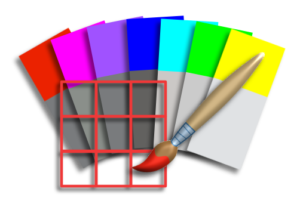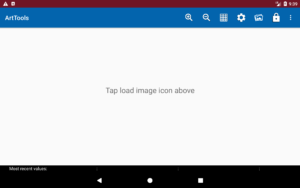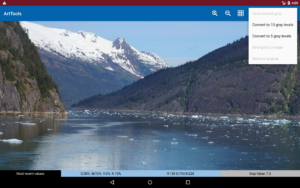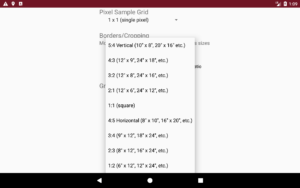Combined GrayScaler and Grid Tool
Now available new version 1.7 from the Google Play Store!
The design and composition of areas of color and value, especially value, determine the success of a painting or drawing.
To my disappointment, until now, there have been no color-picker apps for tablets (or phones) that display the gray values of an on-screen image — only the RGB (red, green, blue) values of pixel colors. However, this information is almost useless for “real paint” (non-digital) painting purposes. (For a nice description of the difference between mixing RGB colors and mixing paint and why RGB is not very useful to painters, click here.)
To remedy this situation I wrote and released a grayscale color-picker-type app for Android last year called GrayScaler (see explanation here) to display gray values along with the standard RGB and CMYK values at any pixel in an image. For my own use the original GrayScaler was soon followed by a similar app that allowed me to superimpose various sized grids over an image with an optional border mask to crop the image to common canvas shapes — very helpful for accurate drawing when laying out paintings.
After using these two apps extensively in my own work for awhile, it quickly became apparent that it was not only inconvenient to load the same image into two separate apps and switch between them, but, especially if the image was very hi-resolution, it was a terrible waste of sometimes very limited device memory. Most of the underlying code for the two apps was substantially the same so having them both running at the same time used up even more memory. Combining them into a single app promised to be a great improvement both in convenience and memory usage.
In addition to combining the two apps into one, I added some enhancements to the GrayScaler-based “mode” (including display of the CMYK value of the color) and fixed a couple of possible sources of reported crashes in the original GrayScaler release.
Thus, the birth of ArtTools…
ArtTools How To
(Click on any image below to view a larger “lightbox” version.)
This is the ArtTools startup view with no image loaded. The toolbar shows a series of easy to understand icon buttons and a dropdown menu button.
Zoom In / Zoom Out

Any image loaded into the app can be zoomed in to 5X magnification or back out to minuscule (not that miniscule is very useful), either by pinching/spreading with two fingers on touch screen devices and/or by using the zoom in and zoom out buttons on the toolbar. These buttons were added to the original version of GrayScaler so it can run on Android devices without a touchscreen, like TVs or Android equipped projectors.
Grid on/off
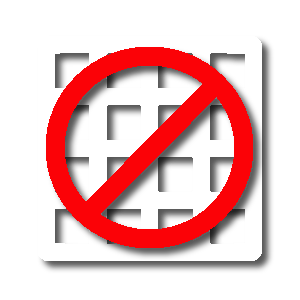
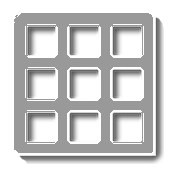
This button toggles a user selected grid (described in “Grid Mode” below) or show grid disabled when the image and grid have been bound.
Settings 
The Settings button opens the settings page (described below).
Load Image 
Load image opens the particular media provider for your device and Android version. On some devices it will even allow access to DropBox and other remote disks. Virtually any jpg or png file is acceptable.
Lock and Unlock Image

This button toggles between locking and unlocking the image. Once an image has been loaded, moved and zoomed to your desired position and scale it can be locked so that it will remain in that state without being inadvertently dragged or pinch- or button-zoomed out of position.
GrayScaler Mode
Once an image is loaded ArtTools is in one of two modes: When no grid is visible, ArtTools is in “GrayScaler” mode and tapping on any area of the image shows a small window with CMYK values, RGB values and the gray value of the pixel or a 3X3 or 5X5 (selected on the Settings page) pixel averaged area centered in the red target circle at the point tapped. Notice the position of the red target circle — when the image is tapped to the right side of the center of the screen, the target appears on the right, and vice versa so the information box does not bump into the left or right side of the screen.
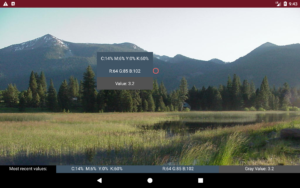
The original GrayScaler only displayed RGB and gray value at the point touched. For painters, CMYK values (Cyan, Magenta, Yellow and Black) are actually more useful since mixing these colors is more like mixing paint. In addition the original GrayScaler would only show the values for a few seconds at the touch-point and then disappear. This new version helpfully adds a bottom information bar showing the value of the last point tapped.
Note: When the image is tapped below the toolbar, the toolbar will disappear. To restore it, tap the screen anywhere near the top of the image within the area that the toolbar normally occupies.
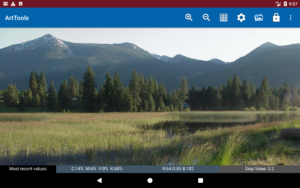
The Options Menu
The dropdown menu provides menu items to:
- convert the loaded image into a 3-gray level, 5-gray level or 10-gray level version
- the gray levels include black and white (this is a fix from previous versions)
- conversion grays are more accurately calculated,
- save the converted image,
- restore the original image.
- NEW: if in Grid Mode, the ability to bind the grid to the image (see explanation below).
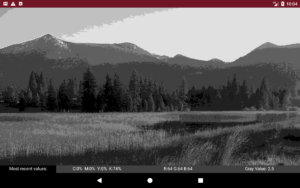
Grid Mode
When the Grid button is tapped, the grid selected on the Settings page will be drawn over the loaded image and the button will toggle to “Grid off.”
Note: The default grid is 3×3 and the default border aspect ratio will define a square image. Both of these settings as well as a few others are described below on the settings page. Settings on the Settings page are saved between “runs” of the app.
Shown below is a 6-space grid with a 4:5 image mask (like a 16″ x 20″ painting). The grid and border are set on the Settings page.

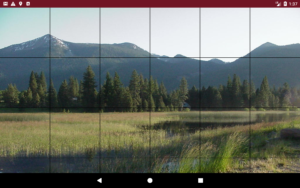
Note: The information bar at the bottom of the screen is hidden in grid mode.
Binding The Grid to The Image
When you have your image zoomed and positioned under a grid, you may want to bind the grid so that both the image and the grid can be zoomed and positioned together. This basically creates a “screenshot” that replaces the original image/grid combination. When you zoom in on a “bound” image, the grid will expand or shrink and move along with it. The only drawback to this approach is that the original grid line thickness will also change when zooming in and out.
When the grid and image are bound, the grid icon in the toolbar is disabled to avoid turning the grid on over the bound image-grid. This would be visually very confusing — a fixed grid would be drawn on top of the bound grid/image.
The Settings Page
The Settings Page allows you to show or hide a cropping border as well as select the color of grid lines. The grid lines default to black, but for some images, especially very dark ones, red lines are easier to see.

Setting the Pixel Sample Grid Size
For a very large, hi-res image, tapping on a specific pixel is impossible, even zoomed in as far as the program will allow. To remedy this problem, the enhanced GrayScaler mode in ArtTools allows you to specify getting the color and gray values of a single pixel or of a 3×3 or 5×5 pixel averaged color and gray value. This pixel sample grid size is selected on the Settings page as shown here:
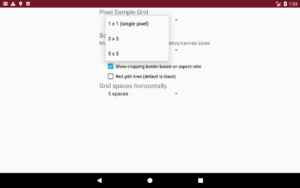
Select The Cropping Border
The cropping border can be selected from a range of the most common canvas sizes of various aspect ratios (height/width).
Note: A future version may provide the ability to enter custom sizes that would automatically calculate arbitrary aspect ratios.
Select The Horizontal Grid Spaces
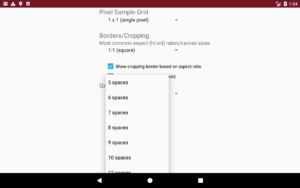
As noted above, these settings are saved between runs of ArtTools. Unfortunately, Android does not allow the saving the loaded image address/filename, so the image must be explicitly re-opened through the device’s MediaStore when ArtTools is subsequently run. It is possible that there is a workaround for this, but I have not found it so far.
If you would like to get started using ArtTools right away, you can get it right now by clicking on the “Buy Now” button below ($2.99), but purchasing from the Play Store will guarantee automatic updates as they become available.
A Flutter language version of ArtTools may become available for Apple iOS devices. Also, a Java version for Mac and Windows desktop machines is now available.
